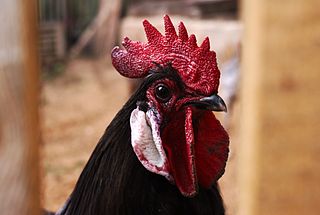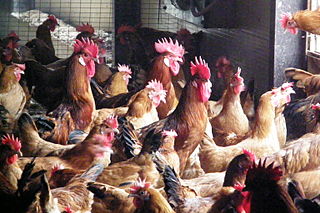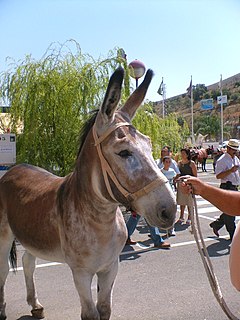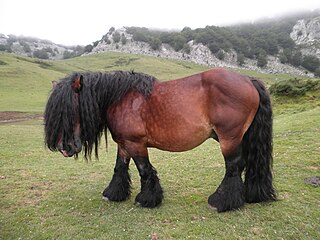
The Araucana is a breed of domestic chicken from Chile. Its name derives from the Araucanía region of Chile where it is believed to have originated. It lays blue-shelled eggs, one of very few breeds that do so.

The Leghorn is a breed of chicken originating in Tuscany, in central Italy. Birds were first exported to North America in 1828 from the port city of Livorno, on the western coast of Tuscany. They were initially called "Italians", but by 1865 the breed was known as "Leghorn", the traditional anglicisation of "Livorno". The breed was introduced to Britain from the United States in 1870. White Leghorns are commonly used as layer chickens in many countries of the world. Other Leghorn varieties are less common.

The Plymouth Rock is an American breed of domestic chicken. It was first seen in Massachusetts in the nineteenth century, and for much of the early twentieth century was the most popular chicken breed in the United States. It is a dual-purpose breed, raised both for its meat and for its brown eggs. It is resistant to cold, easy to manage, and a good sitter.
The Pita Pinta Asturiana is the only breed of chicken indigenous to the principality of Asturias, in north-western Spain.

The Andalusian or Blue Andalusian, Spanish: Andaluza Azul, is a breed of domestic chicken indigenous to the autonomous community of Andalusia in south-west Spain. It is distributed through much of the countryside of Córdoba and Seville, and is concentrated particularly in the area of Utrera, which is considered the heartland of the breed. In 2009 the population was estimated at 10,000 birds.

The Sayaguesa is an endangered Spanish breed of domestic cattle. It is named for the comarca of Sayago in the province of Zamora, in the western part of the autonomous community of Castile and León, and is raised almost exclusively in that area. It may also be known as the Zamorana, the Moles de Sayago or the Castellana variedad Sayaguesa. It was traditionally kept mainly for draught work, but is now raised principally for meat.

The Magpie is a British breed of domestic duck. It has distinctive black and white markings reminiscent of the European magpie, and is a good layer of large eggs.

The Minorca, Catalan: Gallina de Menorca, Spanish: Menorquina, is a breed of domestic chicken originating in the Mediterranean island of Menorca, in the Balearic Islands to the south-east of Spain. It is a well-known exhibition bird in many countries of the world, but in the island of Menorca is an endangered breed and considered to be at risk of extinction.

The Catalana, Catalan: Pota Blava, Spanish: Gallina del Prat or Catalana del Prat, is a Spanish breed of domestic chicken. It originates in the area of El Prat de Llobregat in the comarca of Baix Llobregat, in Catalonia in eastern Spain. It may also be called the Catalana del Prat Leonada or Buff Catalana for its golden plumage. The Catalana is a hardy dual-purpose breed kept for both eggs and meat.

The Penedesenca is a breed of chicken originating in the Spanish region of Catalonia, in the area around Vilafranca del Penedès, the main town of the historical Penedès region. It was developed in the first half of the 20th century from native barnyard chickens, and today is noted for its dark brown eggs, said to be among the darkest of any breed of chicken.

The Andalusian, Spanish: 'Asno Andaluz', is a breed of domestic donkey native to the province of Córdoba in Andalusia, Spain. It is also known as the Asno Cordobés after the city of Córdoba or the Asno de Lucena because of its alleged origin in the town of Lucena, Córdoba. It is considered the oldest of the European breeds, at some 3,000 years, and today is rare.

The Asturcón is an ancient breed of small horse or pony from the autonomous region of Asturias in northern Spain. It has been documented since Roman times: it has an unusual ambling gait, which was described by Pliny the Elder in his Naturalis Historia. It is of Celtic type, and shows similarity to the Pottok and Losino of Spain, the Garrano of Portugal, and the Dartmoor, Exmoor, Fell, Highland, Shetland and Welsh breeds of the British Isles.

The Basque Mountain Horse is a breed of horse from the Basque Country of Spain and France. It is listed in the Catálogo Oficial de Razas de Ganado de España, the official catalogue of livestock breeds of Spain, in the group of autochthonous breeds in danger of extinction. The original breed standard of the "Euskal Herriko Mendiko Zaldia / Caballo de Monte del País Vasco", officially approved on 21 July 1999 and published in the Boletín Oficial del País Vasco, the official bulletin of the Basque Country, was repealed in 2015 and replaced with a new one.

The Zamorano-Leonés is a breed of large domestic donkey from the provinces of Zamora and León, in the autonomous community of Castilla y León, in north-western Spain. The name derives from those of the two provinces.

The Balearic donkey, Catalan: 'Ase Balear', Spanish: 'Asno Balear', is a breed of domestic donkey indigenous to the autonomous community of the Balearic Islands, in the Mediterranean off the eastern coast of Spain. Although found mainly in Mallorca, the largest island of the group, it is found also in Menorca, where it was much used for mule-breeding; it is no longer present in the islands of Eivissa and Formentera. It is officially called the Catalan: 'Raça Asenca Balear'; until 2006 the breed was known as the Raça Asenca Mallorquina, and was also referred to as the Ase MallorquÍ, Asno Mallorquín or Mallorquin donkey.

The Euskal Oiloa, Spanish: Gallina Vasca, is a breed of domestic chicken from the autonomous community of the Basque Country in north-eastern Spain and south-western France. It is the traditional rural chicken of the area, a rustic dual-purpose breed of Atlantic type, and differs from Mediterranean Spanish breeds such as the Castellana Negra and the Minorca in several respects: it has yellow legs and feet, red earlobes, and lays brown eggs.

The Bruna dels Pirineus, Spanish: 'Bruna de los Pirineos', is a breed of cattle from the south-eastern Pyrenees, in the northern part of Catalonia. It derives from cross-breeding of local cattle with Swiss Braunvieh stock imported in the nineteenth century through France and through the Val d'Aran. It is distributed throughout the northern comarcas of Catalonia, Alta Ribagorça, Alt Urgell, Berguedà, Cerdanya, Pallars Jussà, Pallars Sobirà, Ripollès, Solsonès and Val d'Aran. The Bruna dels Pirineus constitutes about 80% of the beef herd of Catalonia.




















